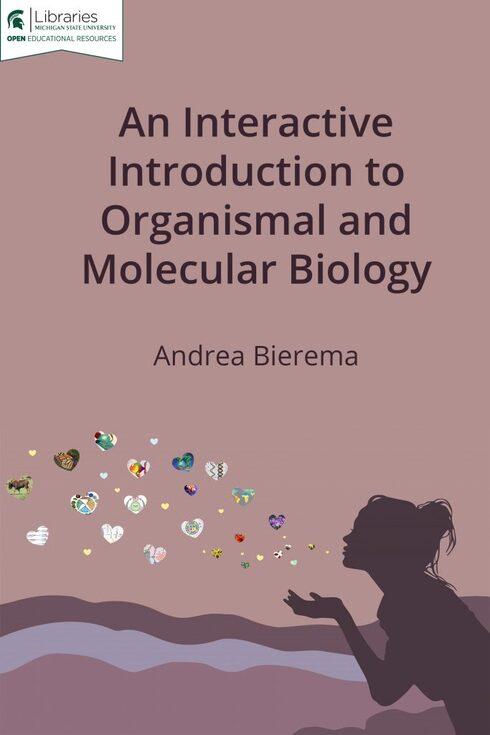
An Interactive Introduction to Organismal and Molecular Biology
![]()
![]()
![]()
![]()
![]()
Andrea Bierema, Michigan State University
Copyright Year: 2021
ISBN 13: 9781626101067
Publisher: Michigan State University
Language: English
Formats Available
Conditions of Use
![]() Attribution-NonCommercial-ShareAlike
Attribution-NonCommercial-ShareAlike
CC BY-NC-SA
Reviews
I think the title is a bit misleading. Most of the chapters in the "Organismal Biology" section are about ecology (e.g., Biodiversity, Population Growth, Species Interactions). The "Reproduction" chapter is primarily about cell division and... read more
![]()
![]()
![]()
![]()
![]()
I think the title is a bit misleading. Most of the chapters in the "Organismal Biology" section are about ecology (e.g., Biodiversity, Population Growth, Species Interactions). The "Reproduction" chapter is primarily about cell division and doesn't really fit in with the other chapters in the section or under the heading of "Organismal Biology.
The second section "Molecular Biology" seems more comprehensive. It covers the basics of protein structure and function, gene expression, and more.
There is no glossary or index.
The information seems to be accurate.
The examples are up-to-date and interesting. I like the inclusion of Genetic Engineering.
It isn't clear if the book is used for majors or non-majors. I think that some students (non-majors in particular) would struggle with some chapters. For example, the Carbon Cycle chapter would be challenging for students with no prior knowledge of the topic. Also, in Ch 16: Protein Structure and Function, there is a large section on mutations and how they affect phenotype. This chapter precedes Gene Expression so students may struggle to see the connections.
Yes. Each chapter is organized similarly and includes a combination of text, videos, and interactive exercises.
I saw no inconsistency in terms of terminology.
Yes. I love the way each chapter is organized. I believe it would appeal to students. The text is readable. The interactive activities and examples are interspersed throughout each chapter.
The topics are presented in an order that I find a bit confusing. However, the author explains that the book was written for her classes. I'm sure in that context, the order is clearer.
As I stated earlier, the name of the book and the names of the sections don't really fit the content. The "Organismal Biology" section seems to be Ecology and Evolution.
This book looks great and is easy to navigate.
Overall, the writing is good. But could use additional proofreading. e.g. Ch 15 starts with "This unit addresses how DNA is read to create protein and that proteins determine an organism’s characteristics."
Yes. The author has obviously made an effort to make sure the text is culturally sensitive and inclusive. She cites projectbiodiversity.org a source for some of her examples.
Overall, I think this is a good textbook. I think students would like the organization and benefit by the inclusion of the interactives and examples in each chapter.
Table of Contents
- I. Introduction to Science
- 1. Nature of Science
- 2. Scientific Controversies
- 3. Information Communication
- 4. Stakeholders and Authority
- 5. Bibliographies
- II. Organismal Biology
- 6. Introduction to Ecology
- 7. Biodiversity
- 8. Systems Thinking and the Carbon Cycle
- 9. Climate Change
- 10. Species Interactions
- 11. Population Growth
- 12. Evolution
- 13. Phylogenetic Trees: Modeling Evolution
- III. Molecular Biology
- 14. Introduction to Molecular Biology
- 15. Protein Structure and Function
- 16. Protein Synthesis Overview
- 17. Protein Synthesis I: Transcription
- 18. Protein Synthesis II: RNA Processing
- 19. Protein Synthesis III: RNA Interference
- 20. Protein Synthesis IV: Translation
- 21. Protein Synthesis V: Additional Regulation
- 22. Genetic Engineering
Ancillary Material
Submit ancillary resourceAbout the Book
This "textbook" is interactive, meaning that although each chapter has text, they also have interactive HTML5 content, such as quizzes, simulations, interactive videos, and images with clickable hotspots. Students receive instant feedback when they complete the interactive content, and therefore, can learn and check their understanding all in one place. The first unit introduces students to the nature of science, including scientific controversies, and information literacy, including how to analyze literature and identify stakeholders. Unit 2 is organismal biology, including carbon cycling and population growth, and unit 3 is molecular biology with a focus on gene expression.
About the Contributors
Author
Andrea Bierema, Michigan State University
